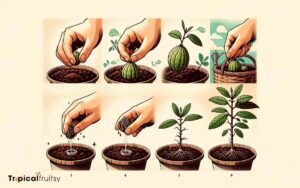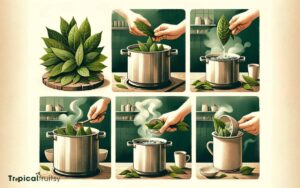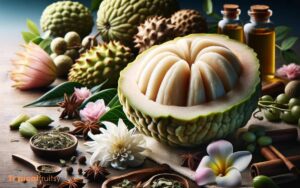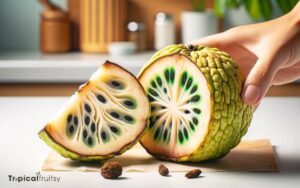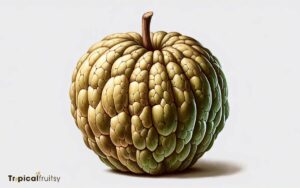How to Tell If a Cherimoya Is Ripe
To determine if a cherimoya is ripe, look for a change in skin color from bright green to a paler shade. The fruit should yield slightly under gentle pressure, similar to a ripe avocado.
Small brown spots may be present but are not necessarily a sign of spoilage. Ripe cherimoyas will emit a sweet, tropical smell, and the stem should detach easily if the fruit is fully ripe.
Identifying a ripe cherimoya is essential for enjoying its optimal flavor and texture.
Here are the key indicators of ripeness:
Select a ripe cherimoya with confidence by noting its color, texture, aroma, and stem condition.
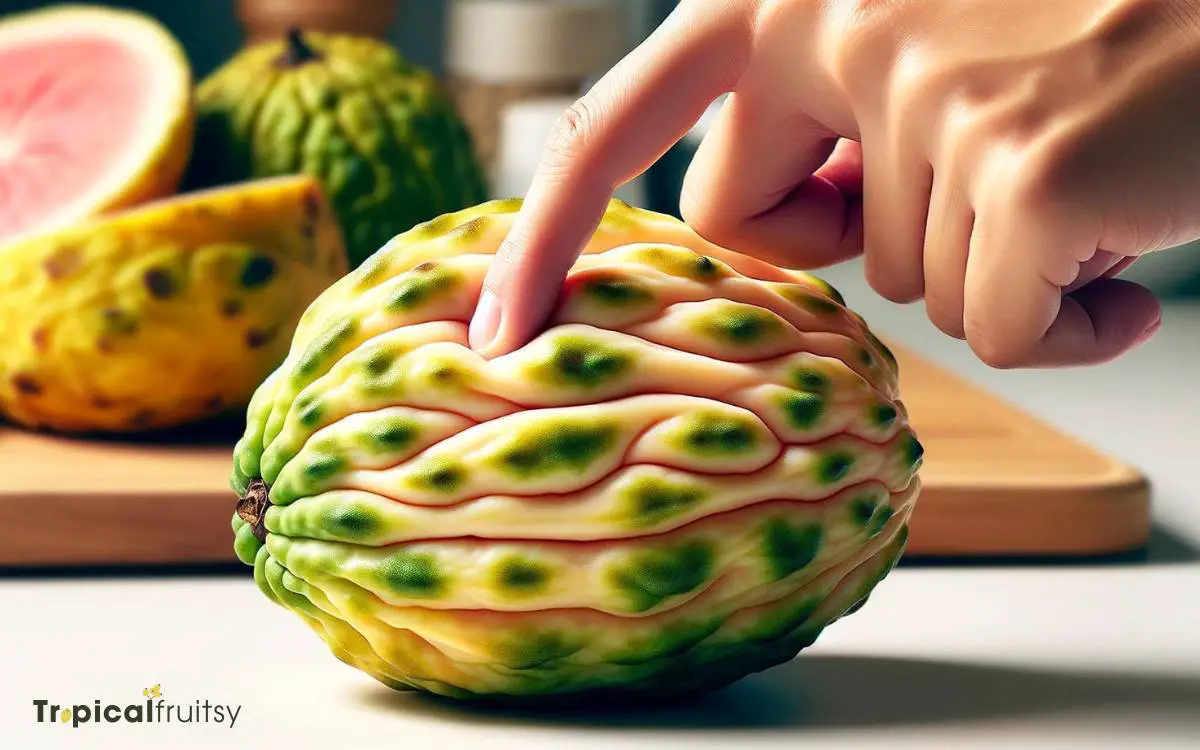
Key Takeaway
Step 1: Assessing Skin Color Changes
As a cherimoya ripens, its skin turns from vibrant green to a more muted green or even brownish hue. This progression is a direct result of chlorophyll breakdown and the concomitant biochemical changes within the fruit’s epidermal layers.
Astute observers will notice the transition as a gradual shift, often accompanied by the appearance of brown spots indicative of increased sugar concentration and enzymatic activity. It’s imperative to discern this coloration shift carefully, as premature harvesting results in a markedly lower quality of flavor and texture.
Conversely, allowing the fruit to overripen can lead to an unpleasantly mushy consistency. Monitoring the skin’s pigmentation provides a visual gauge of ripeness, setting the stage for the next critical assessment: feeling for softness.
Step 2: Feeling for Softness
Feeling the cherimoya’s surface, you’ll find that a ripe one yields slightly to gentle pressure, indicating it’s ready to eat. The cherimoya’s skin, when ripe, possesses a certain give upon tactile assessment. This softness is akin to that of a ripe avocado. One must apply a delicate touch, using the pads of the fingers, and press lightly. The fruit shouldn’t be overly mushy, which could signify overripeness.
For an accurate measure of ripeness, conduct a uniform press test around the entire fruit. A cherimoya that’s uniformly soft is typically at its peak. Conversely, if the surface feels hard, the fruit requires more time to mature.
It’s crucial to avoid using excessive force to prevent bruising the flesh, which can negatively affect texture and flavor.
Step 3: Checking for Brown Spots
When assessing a cherimoya’s ripeness, the presence of brown spots is a critical indicator. These spots’ hue not only signifies maturity but also reflects the fruit’s internal condition.
An expert evaluates the number and texture of these spots to accurately gauge the cherimoya’s readiness for consumption.
Spot Color Significance
Brown spots on a cherimoya’s skin often indicate the fruit is approaching optimal ripeness. These spots are critical visual cues that reveal the maturity level of the fruit and should be inspected closely for the following characteristics:
- Spot Texture:
- Smooth: Suggests that the brown coloration is a natural part of the ripening process.
- Raised or sunken: May be a sign of bruising or decay.
- Spot Distribution:
- Evenly spread: Indicates a uniform ripening process.
- Clustered in one area: Could point to uneven ripening or potential damage.
Assessing the significance of these spots requires not only noting their color but also their texture and distribution. This analysis will segue into the importance of evaluating the brown spots’ amount.
Brown Spots Amount
While assessing the texture and distribution of brown spots is crucial, it’s also important to consider their quantity, as an abundance of spots typically signifies that a cherimoya has reached full ripeness.
A ripe cherimoya will often display a mosaic of tiny brown spots across its green skin. These spots emerge as the fruit’s sugars develop and cellular changes occur within the skin, indicating a peak in flavor and texture.
However, one must differentiate between a healthy speckling and an overabundance suggesting overripeness or spoilage. An optimal number of brown spots is sporadic yet evenly distributed, without clustering or blackening, which can denote decay.
Consequently, the consumer should inspect the cherimoya for a balance in brown spot quantity to ensure the acquisition of a fruit at its prime.
Spot Texture Interpretation
One must also feel the texture of a cherimoya’s brown spots, as they typically soften and become slightly indented when the fruit is ripe. The tactile examination requires a gentle touch to prevent bruising the fruit.
Here’s how to interpret the spot texture: – Surface Indicators: – Softness: Ripe spots yield slightly under pressure. – Indentation: Gently press to check for a subtle give.
- Visual Cues:
- Color Depth: Ripe spots may appear darker.
- Size Variation: Larger spots often indicate ripeness.
The spots’ texture is a critical factor—too hard indicates under-ripeness, while excessive softness could mean over-ripeness.
Now, to further ascertain a cherimoya’s ripeness, one transitions to sniffing for a sweet aroma, which is another telltale sign of readiness for consumption.
Step 4: Sniffing for Sweet Aroma
As one approaches a ripe cherimoya, they should detect a distinct, sweet fragrance indicative of its readiness for consumption. The intensity of the aroma may vary, with a stronger scent often signaling a higher degree of ripeness.
Experts suggest that a subtle yet noticeable fruity smell is the optimal indicator for selecting a cherimoya at its peak flavor profile.
Identify Distinct Scent
Upon approaching a cherimoya, one’s nose is greeted by a subtly sweet scent when the fruit is ripe. This olfactory signal is crucial in assessing ripeness:
- Olfactory Assessment
- Intensity: A ripe cherimoya emits a noticeable yet delicate fragrance. The intensity should be pleasant, not overwhelming.
- Quality: The aroma should have a tropical nuance, reminiscent of a blend of banana, pineapple, and papaya.
Experts suggest that the scent should be discernible without being overpowering. As the cherimoya matures, its olfactory profile becomes more pronounced, indicating a readiness for consumption. It’s essential to avoid fruits with an alcoholic or sour smell, as this suggests overripeness or possible fermentation. Thus, sniffing for the sweet aroma is a nuanced but reliable method for selecting a prime cherimoya.
Aroma Intensity Variation
The fragrance of a cherimoya varies in intensity, offering a clear indicator of its ripeness as it grows stronger and sweeter to the nose. As the fruit matures, volatile compounds responsible for aroma, such as esters and alcohols, increase in concentration, resulting in a more pronounced scent. A ripe cherimoya emits a rich, tropical fragrance reminiscent of a blend of banana, pineapple, and papaya.
To assess ripeness by aroma, one should gently sniff the cherimoya near the stem and blossom ends. A subtle, sweet and slightly floral fragrance suggests the fruit is nearing optimal ripeness. If the scent is overpowering or fermented, it may indicate overripeness. Conversely, an absence of aroma often means the cherimoya requires further ripening.
Step 5: Testing Stem Firmness
Cherimoya ripeness can often be gauged by the firmness of its stem, which should yield slightly to gentle pressure when the fruit is ready to eat. Assessing stem firmness is a delicate process. Apply light pressure with your thumb and forefinger. Do not squeeze too hard; excessive force can damage the stem and affect the fruit’s integrity. Observe for a subtle give; a rock-hard stem indicates under-ripeness, whereas a mushy stem suggests over-ripeness.
A technically ripe stem is neither brittle nor spongy but demonstrates a resilient firmness that mirrors the fruit’s interior readiness. This assessment complements other ripeness indicators, providing a multi-faceted analysis for optimal consumption timing.
Moving beyond stem firmness, one’s attention should next turn to observing shape and texture for further ripeness cues.
Step 6: Observing Shape and Texture
Texture serves as a reliable indicator, revealing a cherimoya’s ripeness through its tactile feedback when held. A mature cherimoya typically exhibits a slightly yielding surface upon gentle pressure, akin to a ripe avocado. The skin texture should feel somewhat bumpy, as the fruit naturally possesses protuberant scales. However, these shouldn’t be excessively hard or unyielding. An over-ripe cherimoya might feel mushy and lack structural integrity, indicating a decline in freshness.
Observing the fruit’s shape also provides clues. An optimally ripe cherimoya maintains a uniform, heart-like contour without any irregular depressions. If the shape appears distorted or overly asymmetrical, it may suggest uneven ripening or past damage. Precise assessment of these physical attributes ensures the selection of a cherimoya at peak edibility.
Step 7: Storing for Optimal Ripeness
Observing a cherimoya’s shape and texture can help determine ripeness, but proper storage is crucial for maintaining that peak condition. Once the cherimoya reaches the desired level of ripeness, individuals should:
- Store at room temperature:
- Away from direct sunlight
- In a well-ventilated space
Refrigerate to extend freshness: – Place in a plastic bag with perforations for airflow – Consume within two to three days to prevent over-ripening
Conclusion
In conclusion, determining the ripeness of a cherimoya is no trivial pursuit. One must become a fruit whisperer, discerning the subtleties of hue, succumbing to the seduction of softness, and interpreting the whispers of sweet scents.
Ignore the siren call of appearance; it’s the inner softness and the secretive scent that betray the cherimoya’s readiness.
Store with care, lest your culinary aspirations with this delectable fruit turn as brown as the overripe spots you were warned to avoid.

